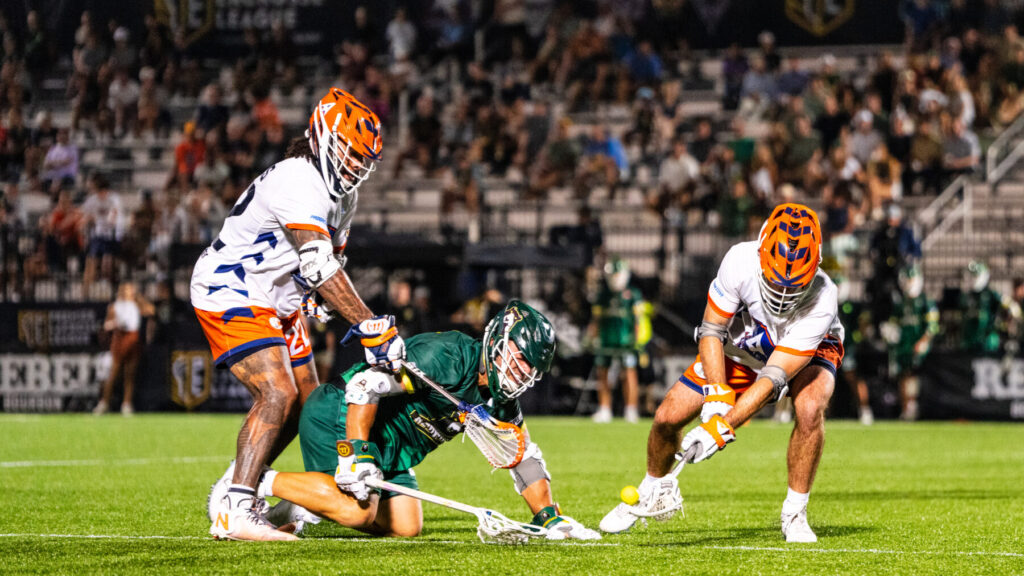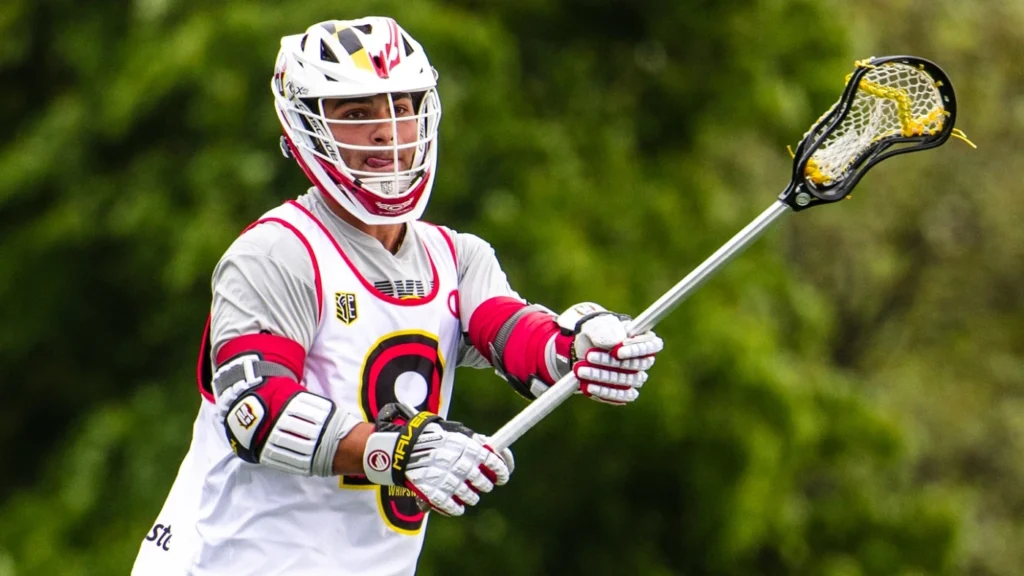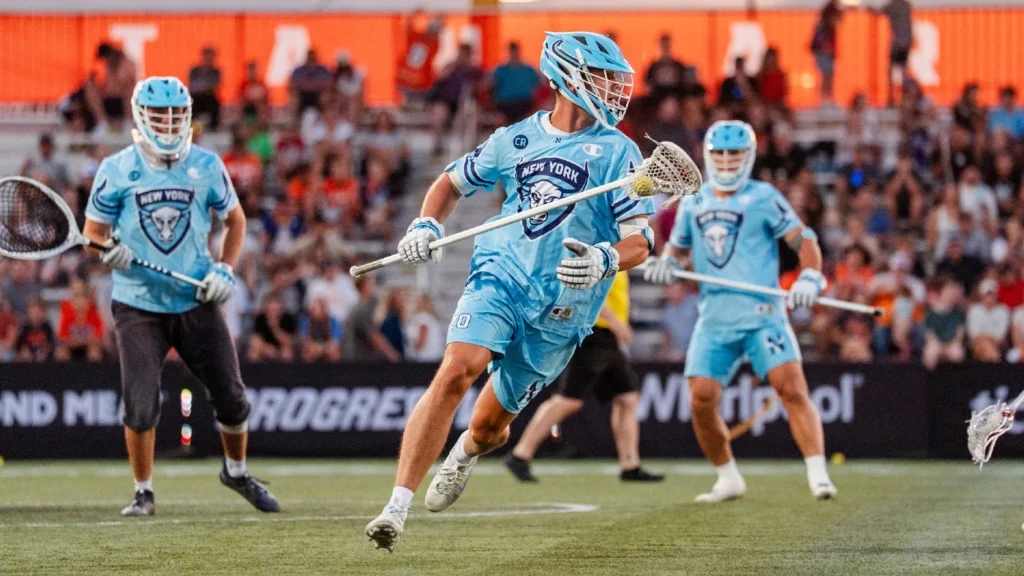
How the Archers Defense Held Redwoods to the Fewest Goals in PLL History
By Zach Carey
Jul 18, 2023
Entering Friday night’s contest between the Archers and the Redwoods, Rob Pannell sat at 298 career goals, just two away from becoming the fifth player in professional lacrosse history to score 300.
Through not even five minutes of play, 298 became 299 when Pannell dodged from behind the cage and sliced through the Archers defense to score lefty and put the ‘Woods up 1-0. It seemed only a matter of time before 300 came as he and partner in crime Ryder Garnsey — who was leading the PLL in scoring — looked set for another electric performance at attack.
But, after his 299th career goal, Pannell proceeded to shoot 0-6 and turn the ball over seven times for the remainder of the game. Garnsey scored with 1:34 left in the first quarter and Wes Berg tacked on another with 10:08 left in the second, but those would be their only and the club’s final goals of the game as the Archers defense utterly overwhelmed the Redwoods offense.
The Archers stymied John Grant Jr.'s group, holding the ‘Woods to just three goals, zero scores for the final 34:08 of game time, an 11.5% shooting percentage, and only 13 shots on goal. The three points allowed are tied for the lowest in a PLL game ever.
So, how did the Archers defense and Defensive Coordinator Tony Resch do it? How did they hold an offense averaging 11.8 goals per game to just three?
The success the Archers defense had was a result of quality goalie play, close defenders who can win matchups on and off the ball, and a defensive scheme that the players know and can execute effectively.
Brett Dobson is playing at an elite level for the Archers
Life is a lot easier for a defense when it can trust the goalie to stop certain shots and dictate that the opposing offense takes them. Brett Dobson’s 60.5% save rate (2nd in PLL) and his 69 saves (also 2nd) through five games represent how stellar of a first half of the season he’s had. Against the Redwoods Dobson made 10 stops, consistently deflecting close shots with his body.
“This guy played unbelievable,” said Mac O’Keefe as he sat next to Dobson in the postgame press conference. “He gave us a chance right from the start. When your goalie is playing like that, when your defense is playing like that, it makes your offense just feel that much more confident.”
The Archers defense may have only allowed the Redwoods to take 13 shots on goal, but Dobson came up big when called upon. He allowed the defense to play confidently, largely only giving up shots that had little chance of getting past the Canadian keeper.
Here, Warren Jeffrey plays Pannell’s top shoulder, focusing on driving him out and defending top-side, but giving up the shot off the question mark. Dobson stays big, using his shoulder to make the save. Because of the faith in Dobson to make that stop, Jeffrey could settle for allowing the low angle shot while preventing the easier look had he given up top-side.
“It’s not just me, it’s on all of them because they give up shots I want to see,” said Dobson after the game. “And then, if they get beat, I try my best to bail them out.”
Dobson is no stranger to bailing his defense out. His quick hands and effective use of his body to track shots and take up as much space as possible make it difficult to score on him no matter where a shot is taken. In this sequence below, Sergio Perkovic sweeps through the defense and comes charging downhill towards Dobson. The shot comes in towards Dobson’s off-stick hip, but he sweeps his hands low and across his body to get a piece of the ball with the shaft of his stick.
When a defense can rely on its goalie to make both the expected and unexpected saves, confidence soars and everyone can dial in on their individual matchup.
Graeme Hossack, Warren Jeffrey, and Matt McMahon dominated their matchups
Beyond Dobson, the play of the Archers close defense on Friday night was especially impressive. The Redwoods have a scary attack line. Garnsey and Pannell entered the game first and fourth in the league in scoring while Wes Berg remains the epitome of efficiency relative to his low usage.
But the combination of Graeme Hossack, Matt McMahon, and Jeffrey was simply too much.
“Anytime you put Graeme Hossack on somebody’s best player who’s played really well it’s an opportunity to shut them down,” said Dobson. “Ryder Garnsey is an MVP candidate this year and we put Graeme on him. You put Graeme on him and it brings him back down to earth. I thought he did a great job.”
Hossack contained Garnsey as a dodger, using his superior size and strength to knock him off his line while constantly getting checks in on Garnsey’s hands despite having to use a v-hold. Here, he does just that, stopping the lefty attackman from getting a step and pushing him towards the sideline before getting a perfectly timed lift check in as Garnsey shot the ball. That check took the velocity out of the shot and forced it left.
Jeffrey did a similarly impressive job locking Pannell up. Although McMahon switched onto Pannell at times in the second half, Jeffrey was the primary defender and proved why his return this summer (after missing the 2022 season on the PUP list) has been so important for the Archers.
He handled the matchup with Pannell intelligently, never overplaying the two-handed attackman. The Vermont alum knew which moves Pannell would use when and anticipated changes of direction well.
“He’s very fundamental,” commented Dobson. “He might not pass the eye test for foot speed sometimes, but he’s a hell of a player and he brings some sandpaper that kind of throws guys off their game.”
Pannell consistently dodged to his left hand against Jeffrey, trying to force the lefty to defend him with a v-hold and then looking to use the array of different finishes in his arsenal. But Jeffrey had answers for everything Pannell tried. The righty backhand shot off a lefty dodge from behind which Pannell has incorporated into his game was something he tried multiple times, but Jeffrey caught on.
Here, as Pannell switches from his left to his right hand to take the backwards shovel shot, Jeffrey comes over the top, checking the ball loose and causing a turnover.
Jeffrey and Hossack limiting Garnsey and Pannell’s impact as dodgers led to the Redwoods forcing passes and shots all over the field. Once they were incapable of winning individual matchups, the ‘Woods offense floundered, clearly frustrated, and turned the ball over 24 times with 15 unforced errors.
Matt McMahon was, as ever, the maestro on the backend. When he did guard Pannell he was solid, stripping him of the ball near five-and-five on one possession. But McMahon’s interior matchup with Wes Berg was where he and the Archers defense thrived. Berg typically makes a living off finding space and benefiting off opposing defenses’ mistakes when helping towards the ball. Yet his first quarter goal was the only offense that the Redwoods generated off-ball as McMahon orchestrated a practically flawless performance as the voice of the Archers defense.
A willingness to switch picks pays off for the Archers
The individual performances were critical for the Archers, but so was the team defense as a whole. The decision making off-ball and how the club responded to what the Redwoods threw at them is what took a successful performance to one of the best in the PLL’s history.
When the Redwoods ran picks to try to get a step or generate mismatches, the Archers were typically comfortable switching and letting their short sticks guard one-on-one. The coaching staff trusts Latrell Harris and his rookie counterparts Piper Bond and Connor Maher to not get burned and most often would rather them make the simple switch than force the pole to fight over the pick.
On Friday night, the staff was consistently rewarded for that trust, evidenced by the play below. Maher’s switch onto Pannell after the big-little behind initially looked dangerous. But the UNC product carried with him up-field, making contact to close off top-side, but following behind enough that Pannell couldn’t get his hands free when he turned for the question mark. Because Maher held steady and delayed his opponent on the first two moves, Harris had the time to double with Pannell’s head turned and subsequently force the turnover.
That is the epitome of effective team defense. Maher identifies the need to switch after the pick, makes up for being behind the play by cutting across the top of the crease, and stops one of the best attackmen ever from creating space at five-and-five. Then Harris’ recognition of the opportunity to double and his physicality at the point of contact creates the turnover.
“I thought we were really physical, I thought we engaged them,” said Head Coach Chris Bates. “Coach Resch and Coach Kav did a great job challenging our guys in a positive way to not let them get runs. When we slid and stayed on the double team we were able to put the ball on the ground.”
The Archers have been solid defensively so far this season, but this performance took it to another level. With Mike Sisselberger’s continued success at the faceoff stripe, the diversity of firepower on offense, and the club’s exploitation of the 32-second shot clock after faceoffs, a defense that can dominate matchups and survive switching big-little picks makes this club the league favorites heading into the All Star break.
Resch has established that, if his defense holds a team under nine goals in a game, that means they get ice cream afterwards. “We had ice cream on our mind,” said Dobson postgame. “Under nine, ice cream for the boys. So that’s what we were looking for.”
Suffice to say, the Archers defense got ice cream on Friday night.




